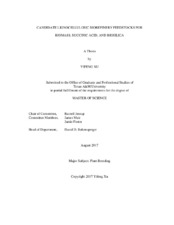| dc.description.abstract | Biofuels produced from non-food lignocellulosic feedstocks have the potential to replace a significant percentage of fossil fuels via high yield potential and suitability for cultivation on marginal lands. Commercialization of dedicated lignocellulosic crops into single biofuels, however, is hampered by conversion technology issues and decreasing oil prices. Integrated biorefinery approaches, where value-added chemicals are produced in conjunction with biofuels, in contrast offer significant potential towards overcoming this economic disadvantage. The objective of this research was to evaluate candidate lignocellulosic feedstocks for potential to produce both primary biofuels and value-added co-products such as succinic acid and biosilica. Feedstock entries included pearl millet napiergrass (PMN), napiergrass, annual sorghum, pearl millet, perennial sorghum, switchgrass, sunn hemp, miscanthus and energy cane. Replicated plots were planted at three locations and characterized for biomass yield, chemical composition including hemicellulose, cellulose, acid detergent lignin (ADL), neutral detergent fiber (NDF), crude protein (CP), silica, and succinate concentration. The PMN, napiergrass, energy cane and sunn hemp had high biomass yield. They were superior candidates for ethanol production due to high cellulose and hemicellulose yield. They also had high silica and succinate yield with the exception of sunn hemp’s low silica yield. Silica yield among feedstock entries ranged from 41 to 3249 kg ha^-1, and succinate yield ranged from 3 to 556 kg ha^-1. Therefore, based on high bioethanol and bioproducts yield potential, the PMN, napiergrass and energy cane are promising biorefinery feedstock candidates for improving biofuel profitability. | en |


